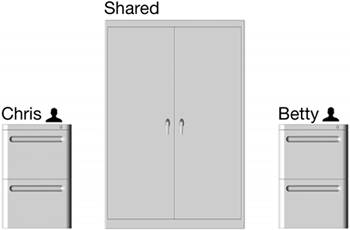Lesson 5. Permissions
|
Time
|
This lesson takes approximately 1 hour to
complete.
|
|
Goals
|
Control access to applications and data files
with file and folder permissions
|
| |
Troubleshoot permissions issues
|
Mac OS X is designed as a multiuser operating
system, with a number of features that help multiple users work on
the same computer while maintaining unique files and settings. In
fact, with fast user switching and remote login, you can even have
more than one user logged in simultaneously. In Mac OS X, to ensure
internal security on your computer, the file system uses
permissions to limit access.
Imagine that your computer is a set of filing
cabinets in an office with a private filing cabinet for each
employee. Each employee's private cabinet is locked, unless they
specifically grant different access to drawers inside their
cabinet. Each employee's private cabinet can have a public in box
where coworkers can leave files and a public out box where
coworkers can take files. An open "shared" cabinet that anyone can
access is available to place files everyone can use.

There are three
categories of users for each filing cabinet:
-
The owner
-
Group members and guests who have access to one
or more drawers inside the cabinet
-
Others who have access to the in box and out
box, but no access to the owner's drawers
You use these categories to define permissions,
such as Read & Write access, Read Only access, or No
Access.
In this lesson you will learn about file access
and permissions issues. The topics will include theoretical and
practical information about the Mac OS X user-based permissions
model, some examples of permissions in context, and how to
troubleshoot file permissions issues.

|